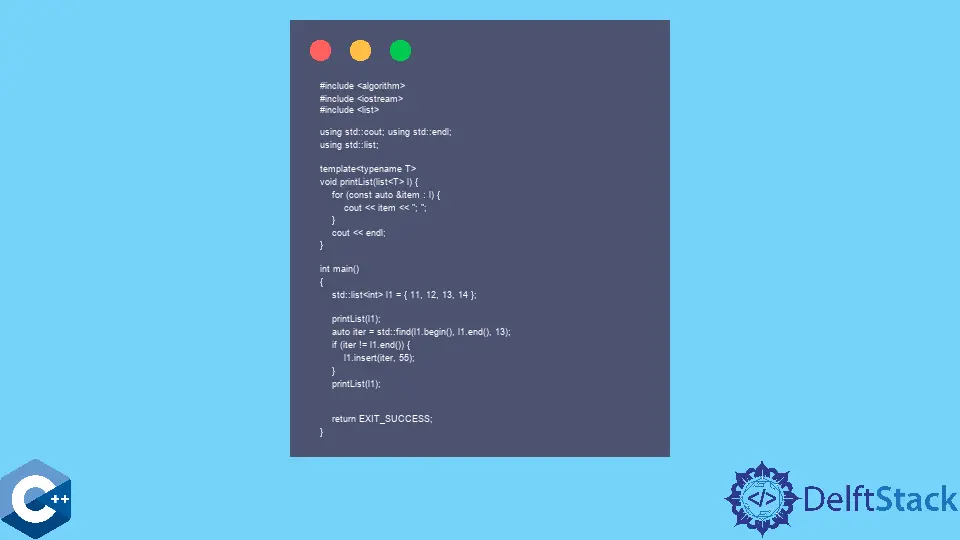在 C++ STL 中使用 STL 列表容器
-
在 C++ 中使用
std::list<T>声明列表容器对象 -
在 C++ 中使用
insert()函数在列表中的指定位置插入元素 -
在 C++ 中使用
swap()函数交换两个列表的元素 -
使用
merge()函数将两个排序列表合并为一个

本文将演示如何在 C++ 中使用 STL list 容器的多种方法。
在 C++ 中使用 std::list<T> 声明列表容器对象
std::list 容器是标准模板库的一部分,它实现了一个列表数据结构,该结构提供恒定时间从任何位置插入/删除元素。它通常被实现为一个双向链表并支持双向迭代而不是 std::forward_list。不利的一面是,std::list 不具备快速随机访问诸如 std::vector 或 std::deque 之类的元素的能力。它只提供两个常量时间函数,front 和 back 来访问第一个和最后一个元素。std::list 可以使用给定的数据类型和通用初始化列表符号进行初始化,如以下示例代码所示。push_back 和 push_front 方法可用于将元素添加到列表的任一侧。
#include <algorithm>
#include <iostream>
#include <list>
using std::cout;
using std::endl;
using std::list;
template <typename T>
void printList(list<T> l) {
for (const auto &item : l) {
cout << item << "; ";
}
cout << endl;
}
int main() {
std::list<int> l1 = {11, 12, 13, 14};
l1.push_front(15);
printList(l1);
l1.push_back(16);
printList(l1);
return EXIT_SUCCESS;
}
输出:
15; 11; 12; 13; 14;
15; 11; 12; 13; 14; 16;
在 C++ 中使用 insert() 函数在列表中的指定位置插入元素
insert() 成员函数可用于在给定位置添加元素。该函数有多个重载,第一个重载只有两个参数:迭代器和对对象的引用。给定元素插入到迭代器指向的元素之前。下一个代码片段展示了如何在列表中查找特定值,然后在它之前插入所需的元素。
#include <algorithm>
#include <iostream>
#include <list>
using std::cout;
using std::endl;
using std::list;
template <typename T>
void printList(list<T> l) {
for (const auto &item : l) {
cout << item << "; ";
}
cout << endl;
}
int main() {
std::list<int> l1 = {11, 12, 13, 14};
printList(l1);
auto iter = std::find(l1.begin(), l1.end(), 13);
if (iter != l1.end()) {
l1.insert(iter, 55);
}
printList(l1);
return EXIT_SUCCESS;
}
输出:
11; 12; 13; 14;
11; 12; 55; 13; 14;
在 C++ 中使用 swap() 函数交换两个列表的元素
std::list 容器的另一个有用的成员函数是 swap(),它将列表对象的元素与作为唯一参数传递的另一个列表交换。请注意,此操作不会移动或复制单个元素,并且所有迭代器/引用在函数调用后仍然有效。
#include <algorithm>
#include <iostream>
#include <list>
using std::cout;
using std::endl;
using std::list;
template <typename T>
void printList(list<T> l) {
for (const auto &item : l) {
cout << item << "; ";
}
cout << endl;
}
int main() {
std::list<int> l1 = {11, 12, 13, 14};
std::list<int> l2 = {1, 2, 3, 4, 11};
cout << "l2: ";
printList(l2);
l2.swap(l1);
cout << "l2: ";
printList(l2);
return EXIT_SUCCESS;
}
输出:
l2: 1; 2; 3; 4; 11;
l2: 11; 12; 13; 14;
使用 merge() 函数将两个排序列表合并为一个
或者,可以使用 merge 成员函数将两个排序列表的元素合并为一个。请注意,两个列表都应按升序排序。merge 引用列表对象,其中的元素合并到调用者对象中。操作后,作为参数传递的列表对象变为空。该函数按升序对结果列表对象的元素进行排序,如以下代码示例所示。
#include <algorithm>
#include <iostream>
#include <list>
using std::cout;
using std::endl;
using std::list;
template <typename T>
void printList(list<T> l) {
for (const auto &item : l) {
cout << item << "; ";
}
cout << endl;
}
int main() {
std::list<int> l1 = {8, 10, 2, 4};
std::list<int> l2 = {7, 3, 9, 5, 1};
l2.sort();
l1.sort();
cout << "l2: ";
printList(l2);
l2.merge(l1);
cout << "l2: ";
printList(l2);
return EXIT_SUCCESS;
}
输出:
l2: 1; 3; 5; 7; 9;
l2: 1; 2; 3; 4; 5; 7; 8; 9; 10;
Founder of DelftStack.com. Jinku has worked in the robotics and automotive industries for over 8 years. He sharpened his coding skills when he needed to do the automatic testing, data collection from remote servers and report creation from the endurance test. He is from an electrical/electronics engineering background but has expanded his interest to embedded electronics, embedded programming and front-/back-end programming.
LinkedIn